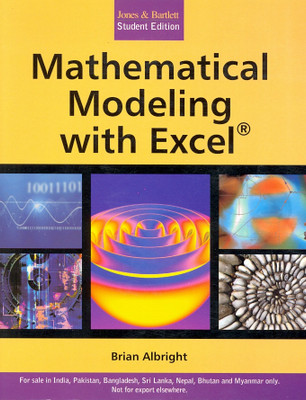MATHEMATICAL MODELLING WITH EXCEL(English, Paperback, Brian Albright)
Quick Overview
Product Price Comparison
Mathematical modeling is the practice of applying mathematics to real-world problems and investigating important questions about their outcomes. Mathematical Modeling with Excel presents the various methods used to build and analyze mathematical models in a format that students can quickly comprehend. Excel is used as a tool to accomplish this goal of building and analyzing the models. Ideal for math and secondary math education majors, this text presents a wide variety of common types of models, as well as some new types not traditionally covered. Each is presented in a unique. Easy-to-understand format. End-of-chapter exercises ask students to modify or refine the existing model, analyze it further, or adapt it to similar scenarios. With a flexible design and student-friendly writing style, Mathematical Modeling with Excel is the clear choice for engaging readers in important modeling techniques, mathematical concepts and application types. Key Features A user-friendly writing style makes the text appropriate for a wide range of students. Topics are covered in a unique way by beginning each section with a theoretical derivation of a model scenario, then showing step-by-step instructions for implementing and dynamically analyzing the model in Excel. Includes an extensive section on simulation models. The analytical spreadsheets, built according to instruction, allow students to dynamically change the values of parameters and analyze changes in the behavior of the model. Solutions, worksheets and the author-created Excel worksheet ŌĆ£ Linear ProgrammingŌĆØ are available on the textŌĆÖs website. About The Author Albright-Concordia University. Brian Albright grew up in Colby, KS. He attended college at Emporia State University where he studied mathematics and secondary education. He went to graduate school at Washington University in St. Louis. Currently he teaches at Concordia University where he lives with his wife and children. Table of Contents What is mathematical modeling? Definitions Purpose The Process Assumptions For further reading References Proportionality and geometric similarity Introduction Using Data Modeling with Proportionality Fitting Straight Lines Analytically Geometric Similarity For further reading References Empirical modeling Introduction Linearizable models Coefficient of determination Polynomials Multiple regression Spline models For further reading References Discrete Dynamical Systems Introduction Long term Behavior and equilibria Growth of a bacteria population A linear predator- Prey model A non-linear Predator-Prey model Differential equations Introduction EulerŌĆÖs Method Quadratic Population Model VolterraŌĆÖs Principle Lancester Combat models Eigenvalues For Further reading References Simulation modeling Introduction Basic examples The Birthday problem Random Number Generators Modeling Random Variables Approximating Density Functions A theoretical queuing model A Coffee shop queuing model A scheduling model An inventory model For further reading References Optimization Introduction Linear Programming The transportation problem The assignment problem and binary constraints Solving linear programs The simplex method Sensitivity analysis The gradient method For Further reading Reference Spreadsheet basics Basic terminology Entering text, Data and Formulas Creating charts and graphs Array formulas.


